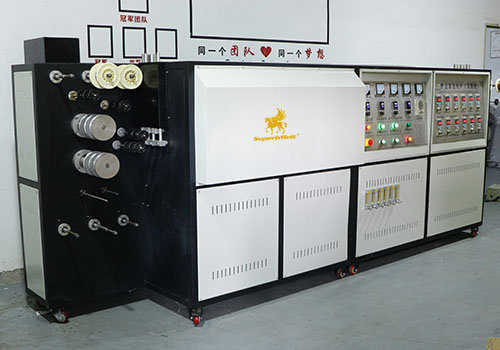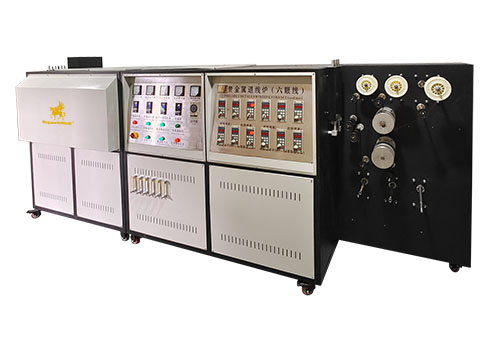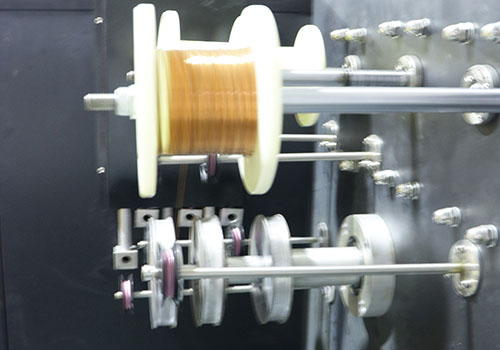Wire Annealing Machine
Using the SuperbMel Wire Annealing Furnace to complete the annealing process for gold, silver, and copper wires


SuperbMelt Wire Annealing Machine is used to heat and cool metal wires (gold, silver, copper, etc.) to alter their properties. Annealing involves heating the wire to a specific temperature and then slowly cooling it down, which helps eliminate internal stress and increase its ductility.
- The annealing process is uniform and efficient, ensuring continuous operation of jewelry weaving machines without chain breakage.
- Annealing can eliminate oxidation and other defects on the metal surface, improving surface smoothness and quality.
After annealing, the wire becomes more ductile and is easier to use in various applications such as jewelry manufacturing, electronics production, and wire forming processes.
| Model number | SPB-AWF3 |
| Power source | 3 phase 380V, 50/60Hz |
| Power | 18 kw |
| Applicable metal | Gold, Silver, Platinum, Palladium, and their alloys |
| Heating length | 1200mm |
| cooling length | 1500mm |
| Max temperature | ≤1000℃ |
| Wire withdrawal diameter | ≥0.3Mpa, flow rate≥20L/min, ≤45℃ |
| Dimension | 4500*800*1500mm |
| Weight | 400 kg |
- Variable Speed: With the help of a frequency converter, speed may be adjusted between 30 and 1000 revolutions per minute, meeting a range of manufacturing needs and increasing efficiency.
- Multiple Protective Gases: Maintains the quality and surface finish of the metal wire during annealing by supporting a variety of protective gases, including argon, nitrogen, ammonia, and liquid hydrogen.
- straightforward Installation: Featuring snap-lock joints and a two-stage connection design, this product is straightforward to install. Internal pipe connections are made of stainless steel, which allows for easy, rust-free construction.
- Flexible Control: Provides flexibility in manufacturing operations and management by enabling individual control of each wire’s speed during four-eye wire annealing.
- Effective Heating: Outfitted with a furnace core that can achieve temperatures as high as 1200 degrees Celsius, this device can efficiently complete the annealing process in just 80 minutes, which reduces processing time and boosts productivity.
- Jewelry Manufacturing: Used for annealing gold, silver, and other metal wires to produce various jewelry items such as necklaces, bracelets, earrings, etc.
- Electronics Manufacturing: Employed for annealing copper wires, aluminum wires, etc., to manufacture electronic components, connectors, wire harnesses, etc.
- Metal Processing Industry: Utilized for annealing various metal wires to produce springs, steel ropes, wire mesh, etc.
- Chemical Industry: Applied for annealing metal wires to manufacture chemical equipment, pipelines, storage tanks, etc.
- Automotive Manufacturing: Used for annealing various metal wires to manufacture automotive parts, body structures, etc.
- Aerospace Industry: Employed for annealing titanium alloys, nickel alloys, etc., to manufacture aerospace engine components, aircraft structures, etc.
Why SuperbMelt Wire Annealing Furnace



Any Question About SuperbMelt wire annealing furnace
Regarding the SuperbMelt Wire Annealing Machine Guide
Wire Annealing
The term “wire annealing” describes the heating and cooling procedure used to modify the characteristics of metal wire, especially its flexibility and hardness. Annealing is the process of heating the wire to a predetermined temperature and then lowering it gradually. This procedure makes the wire more ductile and less prone to internal stress, which improves its malleability and ease of use in a variety of applications. In order to strengthen the mechanical characteristics and increase the workability of metal wires, annealing is frequently employed in the jewelry, electronics, wire forming, automotive, and aerospace sectors.
1.1, Significance of Annealing
Annealing is important because it can change the properties of metal materials, particularly those that are manufactured using a variety of mechanical and thermal methods. The following are some important details on the importance of annealing:
Relieving Internal tensions: The metal structure’s internal tensions brought on by machining, casting, and forging are lessened by annealing. If these pressures are not adequately relieved, the material may deform, distort, or even shatter. Annealing lowers the possibility of failure during further processing or usage by allowing the material to relax and return to its equilibrium condition.
Enhancing Ductility: When metals are subjected to deformation operations like bending, stretching, or shaping, annealing makes them more flexible and less likely to fracture. This is especially important for industries that frequently involve forming, like metalworking.
Improving Machinability: Annealing the metal softens it, which makes it simpler to deal with or process with cutting tools. It enhances the surface finish of the machined items and lessens tool wear and tear.
Refining Microstructure: The process of annealing helps the metal’s microstructure become more homogeneous and refined, which can improve its mechanical qualities including toughness, strength, and hardness. In crucial applications where material integrity is crucial, this is extremely crucial.
Reducing Hardness: By recrystallizing the grain structure and removing dislocations, annealing can aid in returning the original softness and toughness of metals that have undergone operations like cold working or heat treatment. This is essential to preserving the material’s intended qualities.
Eliminating Work Hardening: When metals undergo plastic deformation, a process known as annealing takes place to counteract the effects of work hardening. Annealing is a process that restores the ductility of metal and lessens the effects of work hardening by heating the material to a certain temperature and then gradually cooling it down.
In general, annealing is a crucial step in the production of metal components because it guarantees that the materials have the structural integrity and mechanical qualities needed for the intended uses.
1.2, Introduction to Annealing Method
Annealing is necessary for wire for a few reasons:
Relieving Internal tensions: Internal tensions can build up in wire throughout the production process as a result of rolling, bending, and drawing. Annealing aids in relieving these tensions, avoiding wire distortion, bending, or even cracking.
Improving Ductility: Annealing the wire makes it more ductile, which makes it easier to deal with in a variety of applications. This is crucial in fields like jewelry production, where shaping, bending, and forming wire into complex shapes is required.
Enhancing Workability: Annealed wire can be bent, twisted, or soldered more easily because it is softer and more pliable. This makes it easier to deal with and enables more complex and accurate fabrication techniques.
Increasing Electrical Conductivity: Annealing can increase a wire’s electrical conductivity in sectors like electronics production by decreasing resistance and improving the wire’s microstructure. This is essential to guaranteeing the dependability and effectiveness of electrical circuits and parts.
Reducing Brittleness: Annealing the wire can lessen its brittleness, which will lessen its vulnerability to breaking or fracturing under mechanical stress. As a result, wire-based goods last longer and are more durable.
Overall, annealing is crucial for maximizing the mechanical qualities, workability, and efficiency of wire in a variety of sectors, including wire forming, jewelry creation, electronics, and telecommunications.
1.3,Industries Requiring Annealing Furnaces
Annealing furnaces are needed in a number of industries for different purposes. Among these sectors are:
Jewelry Manufacturing: Precious metals used in jewelry manufacture, such as gold, silver, and platinum, must be annealed. Annealing furnaces are necessary for this process. Annealing contributes to the metal’s softening, which facilitates shaping, forming, and soldering into complex shapes.
Manufacturing of Electronics: Metal wires, foils, and strips used in resistors, capacitors, and connectors are annealed in annealing furnaces in the electronics sector. By enhancing the metal’s ductility and conductivity, annealing contributes to the dependable operation of electrical devices.
Automotive Industry: Metal components used in engines, gearboxes, and chassis, such as springs, wires, and tubes, are annealed in annealing furnaces. Automotive parts are made more durable and functional by annealing, which also helps to reduce tensions, increase formability, and improve mechanical qualities.
Aerospace Industry: High-performance alloys and exotic metals used in aircraft structures and components are annealed in aerospace annealing furnaces. Aerospace component dependability and safety are increased by annealing, which helps to improve mechanical qualities, reduce stresses, and refine microstructures.
Manufacturing of Wire and Cables: In the wire and cable manufacturing sector, annealing furnaces are essential for annealing metal conductors and wires that are used in power transmission lines, communication cables, and electrical wiring. By enhancing the wire’s ductility, conductivity, and formability, annealing contributes to the long-term durability and best possible performance of wire and cable products.
Metal Processing Industry: A variety of metal products, including coils, sheets, bars, and rods, are annealed in metal processing industries using annealing furnaces. Annealing ensures the quality and integrity of metal products for additional processing or fabrication by assisting in the refinement of grain structures, the release of tensions, and the improvement of mechanical characteristics.
All things considered, annealing furnaces are essential to a variety of industries where heat treating metals is necessary to maximize their qualities and functionality in different applications.
Types of Annealing Furnaces
2.1, Vacuum Annealing Furnace
A particular kind of heat treatment apparatus called a vacuum annealing furnace is used to anneal materials under low pressure or vacuum. Vacuum annealing furnaces include the following main characteristics and benefits:
Oxidation Prevention: Vacuum annealing furnaces work by generating a low-pressure or vacuum atmosphere inside the furnace chamber, which stops the material from oxidizing. For materials that are vulnerable to surface reactions or are sensitive to oxygen, this is especially crucial.
Contamination Control: In order to maintain the purity of the annealed material, vacuum annealing furnaces reduce the possibility of contamination by gases or other contaminants found in the ambient. For applications like semiconductor manufacturing or aerospace component manufacturing, where material integrity and cleanliness are critical, this is essential.
Accurate Temperature Control: Vacuum annealing furnaces provide accurate temperature control, enabling the material to be heated uniformly without temperature gradients or hot spots. This guarantees reliable annealing outcomes and aids in obtaining the material’s intended metallurgical qualities.
Swift Heating and Cooling: The lack of air or other gases in the chamber allows vacuum annealing furnaces to heat and cool at swift rates. Because of this, vacuum annealing is perfect for high-speed production operations, resulting in reduced processing times and higher output.
Versatility: A wide range of materials, including metals, ceramics, and composites, can be processed in vacuum annealing furnaces due to their versatility. They are frequently employed in the annealing of titanium alloys, stainless steel, tool steel, and other high-performance materials utilized in the aerospace, automotive, and medical sectors.
Processing in Batches or Continuously: Vacuum annealing furnaces can be configured in batch or continuous modes, offering production flexibility based on the particular needs of the application.
For heat treating materials in a variety of sectors, vacuum annealing furnaces are a necessary piece of equipment because they provide accurate temperature control, oxidation prevention, contaminant control, and quick heating and cooling.
2.2, Box Annealing Furnace
Materials are put in the chamber of a box-shaped heat treatment apparatus called a box annealing furnace for annealing procedures. The following are the main characteristics and benefits of box annealing furnaces:
All sections of the material being handled will receive consistent annealing results because to the homogenous heating provided by box annealing furnaces. Achieving the appropriate metallurgical characteristics and preventing temperature gradients depend on this homogeneity.
Controlled Atmosphere: A lot of box annealing furnaces include the ability to regulate the chamber’s atmosphere, allowing for annealing operations in protective or inert gases like hydrogen or nitrogen. This aids in preventing contamination and oxidation of the material, particularly with reactive or sensitive metals.
Flexibility: A broad variety of materials, shapes, and sizes can be accommodated by box annealing furnaces. They can be used to anneal metals, ceramics, composites, and other materials that are utilized in manufacturing, electronics, aerospace, and automotive industries.
Batch Processing: Several parts or components can be annealed at once using box annealing furnaces, which normally run in batch mode. Due to their capacity for batch processing, box annealing furnaces are the best choice for small to medium-sized production runs because of their increased efficiency and throughput.
Heating profiles that can be customized: A lot of box annealing furnaces include the ability to program heating profiles, which let users set exact temperature ramps, soak periods, and cooling rates based on the material and annealing requirements. This customisation improves process control and guarantees ideal annealing outcomes.
Operation Ease: Box annealing furnaces are ideal for a variety of applications and industries since they are comparatively easy to use and maintain. To guarantee dependable and effective functioning, they are outfitted with monitoring systems, safety measures, and controls that are easy to use.
All things considered, box annealing furnaces offer consistent heating, a regulated environment, adaptability, the capacity to process batches, adjustable heating profiles, and simplicity of use, making them indispensable tools for annealing procedures in a range of industrial applications.
2.3, The Purpose of Tempering
A specialized heat treatment tool used to anneal materials in a regulated atmosphere is an atmosphere-controlled annealing furnace. These furnaces provide accurate control of the atmosphere inside the furnace chamber, usually with the use of gases like hydrogen, nitrogen, or argon. The following are some important details of furnaces for atmosphere-controlled annealing:
The goal of atmosphere-controlled annealing furnaces is to anneal materials while managing the ambient atmosphere’s composition. This aids in stopping undesired reactions during the annealing process, such as oxidation and decarburization.
Features: These furnaces have systems for monitoring and controlling temperature and pressure in addition to introducing and regulating gases inside the chamber. They frequently have insulation, heating components, and chambers made to resist extreme temperatures and preserve a steady environment.
Benefits: Atmosphere-controlled annealing furnaces provide for precise annealing with optimal material properties by managing the atmosphere. Grain structure refinement, mechanical property improvement, and surface finish enhancement are all included in this.
Applications: The aerospace, automotive, electronics, and manufacturing industries use atmosphere-controlled annealing furnaces. They can be used to anneal a wide range of materials, such as ceramics, metals, composites, and speciality alloys.
Customization: Because of the furnaces’ adaptability and customization choices, users can adjust the annealing process to meet certain material needs. To get the appropriate annealing results, parameters including temperature profiles, heating rates, soak periods, and cooling rates can be changed.
Quality Control: Annealing furnaces with atmosphere control aid guarantee dependable and constant annealing outcomes that satisfy exacting requirements and standards. Through their contribution, superior materials with enhanced mechanical properties and performance characteristics are produced.
To sum up, atmosphere-controlled annealing furnaces are crucial pieces of machinery that allow you to precisely regulate the surrounding atmosphere throughout the annealing process. They are essential instruments in contemporary production processes across a range of industries because of their adaptability, flexibility, and quality assurance.
Conclusion
The SuperbMelt Wire Annealing Machine is an essential tool for industries that need accurate annealing procedures. This equipment allows for controlled annealing environments, providing ideal conditions for materials such as metals, ceramics, and composites. Its properties are similar to those of atmosphere-controlled annealing furnaces. It maintains the integrity of the material while boosting desired qualities because of its capacity to stop oxidation and other unwanted processes.
Furthermore, customers can optimize factors like temperature profiles, heating rates, and cooling rates by customizing the machine to meet specific material requirements. This is made possible by its flexibility and customization possibilities. This guarantees accurate and dependable annealing outcomes, satisfying exacting requirements and quality standards in a range of industrial applications.
Essentially, the SuperbMelt Wire Annealing Machine is a key component of the heat treatment toolbox, enabling excellent annealing results and spurring innovation across several industries with its accuracy, dependability, and adaptability.


 © Copyright 2008-2021 Superb Electromachinery Co., Limited
© Copyright 2008-2021 Superb Electromachinery Co., Limited